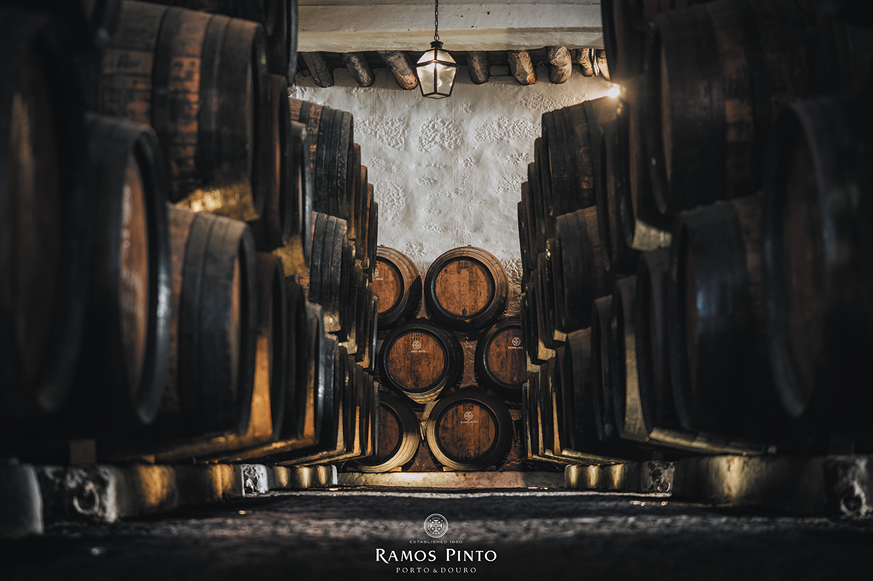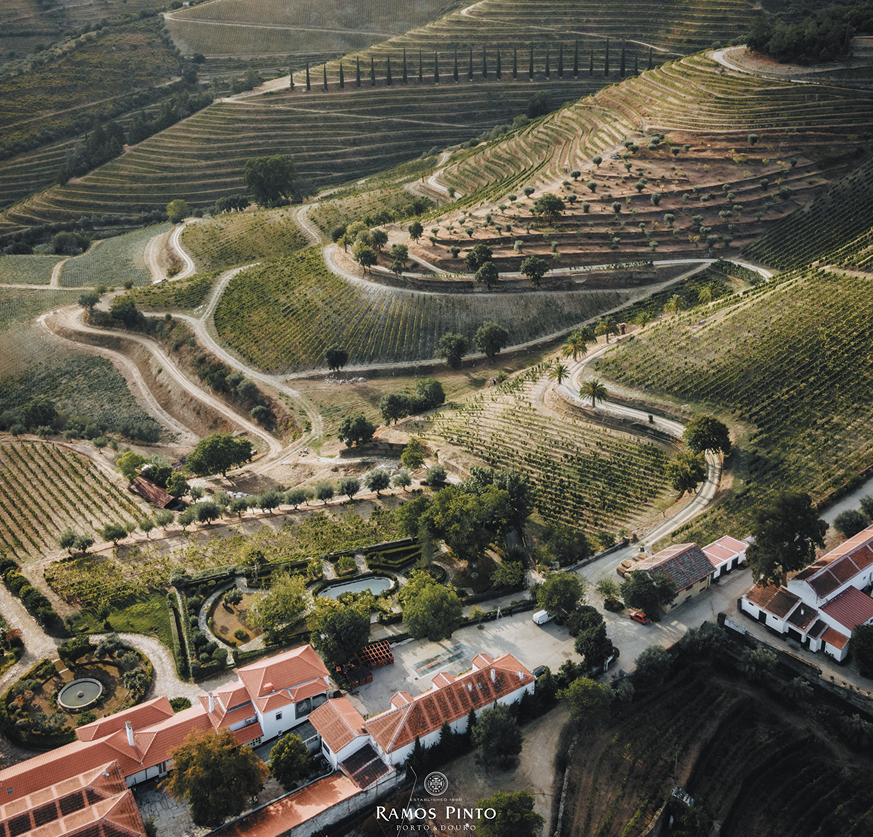- Home
- Media Kit
- MediaJet
- Current Issue
- Past Issues
- Ad Specs-Submission
- Reprints (PDF)
- Photo Specifications (PDF)
- Contact Us
- PRIVACY POLICY
- TERMS OF USE
![]()
ONLINE
![]()
ONLINE

The Distinctiveness
Of Douro Wines
Editors’ Note
Jorge Rosas joined the commercial department of the House of Ramos Pinto in 1986. Having worked for three years in France, Belgium, and the United Kingdom, he returned to Porto in 1996 to take over as wine export director at the House of Ramos Pinto. In 2014, he became director while his cousin, João Nicolau de Almeida, was still managing director. When the latter retired in 2016, Rosas took over at the helm of this famous House, a responsibility that he continues to hold to this day.
Winery Brief
Founded in 1880 by brothers Adriano and Antonio, Ramos Pinto’s (ramospinto.pt/en) history has been marked by a balance between innovation and respect for tradition. In addition to producing wines of exceptional quality, the House is known for its knowledge of terroir and for its pioneering viticulture. Through its strict production policy, the selection of the best Douro grape varieties, and the systematic technical and technological research, the House is positioned as the reference for the production of superior quality wines in Portugal. In 1990, Ramos Pinto was acquired by Maison Louis Roederer. Today, descendants of the founders carry on the heritage of producing extraordinary ports and still wines. Ramos Pinto has four estates in the Douro Valley: Quinta do Bom Retiro and Vinha da Urtiga, located in Cima Corgo, as well as Quinta dos Bons Ares and Quinta de Ervamoira, in the Douro Superior. These four Quintas cover an area of 890 acres.
Will you discuss the history and heritage of Ramos Pinto?
Ramos Pinto, founded by my great-grandfather and his brother in 1880, has a rich history and heritage marked by a balance between innovation and a deep respect for tradition. The House has played a significant role in the production and selection of high-quality Portuguese grapes, showcasing a profound understanding of the natural environment in which Ports are produced and pioneering the launch of DOC. Douro wines worldwide. This initiative not only highlights Ramos Pinto’s willingness to explore new avenues, but also demonstrates its dedication to promoting the distinctiveness of Douro wines on the international stage.
The heritage of Ramos Pinto is displayed in our two museums. The first, located at our headquarters in Vila Nova de Gaia, features an extensive collection of advertising posters and memorabilia from the late 19th century to the early 20th century. The second, situated in Quinta de Ervamoira, highlights the region’s Roman ruins and the renowned Palaeolithic engravings that played a crucial role in preventing the disappearance of this estate.
In the quest for excellence, Ramos Pinto is independently run to this day, which enables the House to conduct continuous technical and technological research, combining traditional winemaking practices with a forward-looking approach.
Our long-term dedication to our vineyards, and our Douro wines and Ports, is passed down from one generation to the next. This respect and insight are key in producing high-quality, internationally renowned wines. Concerning our Port wines, we are now blending wines passed down by several generations and crafting new wines for generations to come.

Ramos Pinto cellar
Will you provide an overview of Ramos Pinto’s offerings?
Ramos Pinto provides a selection of Port and Douro wines. Port wines are known for their wide variety of different styles – White, Tawny and Ruby – which differ in color, aromas, vinification, and ageing process, and have remarkable quality and longevity. Multiple decisions influence the style of the Port wine, beginning with the selection of the initial blend, as well as the size and the type of wood used for ageing.
In 1990, the integration of the House into the Roederer Group propelled forward a project that began with viticultural research in 1976: the creation of the Ramos Pinto red and white still wines. This was a long adventure that offered some of the most well-known Douro wines, including the brand Duas Quintas.
More recently and for the first time in our long history, we released two new DOC Douro wines: Quinta de Ervamoira, which is produced with grapes from the best plots of this property, and Urtiga, which is made with grapes from a century-old vineyard. With these two releases we entered a new era of Douro wines, as we delve into the distinctive terroir of Ramos Pinto.
Will you highlight Ramos Pinto winery and what guests can experience when visiting the winery?
The Ramos Pinto winery offers a unique and immersive experience for visitors, bringing together the passion for the Douro region, its wine culture, and the company’s rich history. Ramos Pinto owns four estates: Quinta do Bom Retiro and Quinta da Urtiga, in the heart of the region, as well as Quinta dos Bons Ares and Quinta de Ervamoira, in the Douro Superior. The opportunity to visit and explore the estates owned by Ramos Pinto in the Douro region allows visitors to witness the diverse terroirs that contribute to the unique character of Ramos Pinto wines. Visitors can engage in wine tasting sessions, experiencing the distinct flavors and characteristics of Ramos Pinto wines. The winery offers a variety of world class wines from both Porto and Douro that capture the essence of Ramos Pinto’s passion for winemaking and the unique character of its properties in the Douro Valley.
There are also two museums: Casa Adriano Ramos Pinto Museum, located in Vila Nova de Gaia, is a tribute to the company’s historical background, its exceptional wines, and its pioneering contributions, particularly in the realm of Port wine marketing; and Sítio de Ervamoira Museum, the local museum at Quinta de Ervamoira, located in the Côa Valley (UNESCO World Heritage Site), provides guests with valuable information about the region. It not only explores the winemaking heritage, but also highlights the significance of Palaeolithic engravings.

Quinta do Bom Retiro, one of Ramos Pinto’s four estates
in the Douro region of Portugal
What have been the keys to the consistent strength and leadership of Ramos Pinto in the industry?
Ramos Pinto’s enduring strength and leadership in the wine sector can be attributed to a combination of strategic decisions and a commitment to innovation. The adoption of its own production policy has given the winery greater control over the winemaking process, ensuring consistently high quality starting from grape cultivation all the way to bottling and ageing.
The winery’s dedication to research, exemplified by the pioneering work of José António Rosas and João Nicolau de Almeida, has played a crucial role. Their technical study of Douro grape varieties resulted in the selection of the best suited varieties for both Port and Douro wines, today widely adopted by all producers in the Douro Valley. Additionally, the introduction of the partially mechanized vertical plantation method by Ramos Pinto in the Douro Valley demonstrated a forward-thinking approach to vineyard management. This has contributed to the production of high-quality grapes not only at Ramos Pinto, but also up and down the Douro and Port appellations.
The winery’s expertise in addressing challenges posed by extreme climates, particularly in the Douro Superior region, is evident in its study on irrigation. The development of rational irrigation methods highlights adaptability and foresight, ensuring the resilience of Ramos Pinto’s vineyards.
These elements collectively contribute to the winery’s enduring success and influence in the Port and Douro wine trade.
Will you discuss Ramos Pinto’s commitment to sustainability?
Ramos Pinto demonstrates a strong commitment to sustainability through various initiatives aimed at improving its bond with nature and minimizing environmental impact. Some key aspects of Ramos Pinto’s sustainability commitments include:
Organic Farming: Ramos Pinto is actively engaged in implementing organic farming practices. This commitment involves cultivating grapes without the use of herbicides or fertilizers that could harm the environment. The house currently has 62 acres of organic vineyards and 9 acres with biodynamic practices. Our organic goals, totaling 620 acres, include:
• Ervamoira – 370 acres (starting in 2024, with the goal of certification in 2027)
• Bons Ares – 61 acres (starting in 2026, with the goal of certification in 2029)
• Bom Retiro + Urtiga – 193 acres (starting in 2028, with the goal of certification in 2031)
Biodiversity Enhancement: The winery is focused on increasing biodiversity within its vineyards, which is essential for maintaining natural pest control and overall ecological resilience. By actively promoting biodiversity, Ramos Pinto contributes to the long-term sustainability of its vineyard ecosystems.
Herbicide free since 2010: A notable milestone in Ramos Pinto’s sustainability journey is the decision to cease the use of herbicides in 2010. Avoiding herbicides helps improve soil health, preventing water contamination, and contributing to a healthier overall vineyard environment.
Medium/long-term goal of carbon neutrality: We are currently in the process of measuring our carbon emissions with the goal of reaching carbon neutrality. During the next year, we will set out multiple initiatives and key results which will kick-start this process.
Did you always know you had a passion for the wine and spirits industry and what has made the industry special for you?
I spent a large part of my childhood and adolescence in the middle of vineyards and wineries but, at that time, I didn’t realize that I had a great passion for the Douro Valley and its wines. It was only when I spent a few years living in the Champagne region that I realized the magnificence of the wines and the region I grew up in.
Wine has powerful connections to places and cultures setting it apart from other industries. Living in this environment and having the chance to produce internationally recognized wines for their quality, enjoyed by consumers in all corners of the world, is a privilege and a great pleasure.![]()